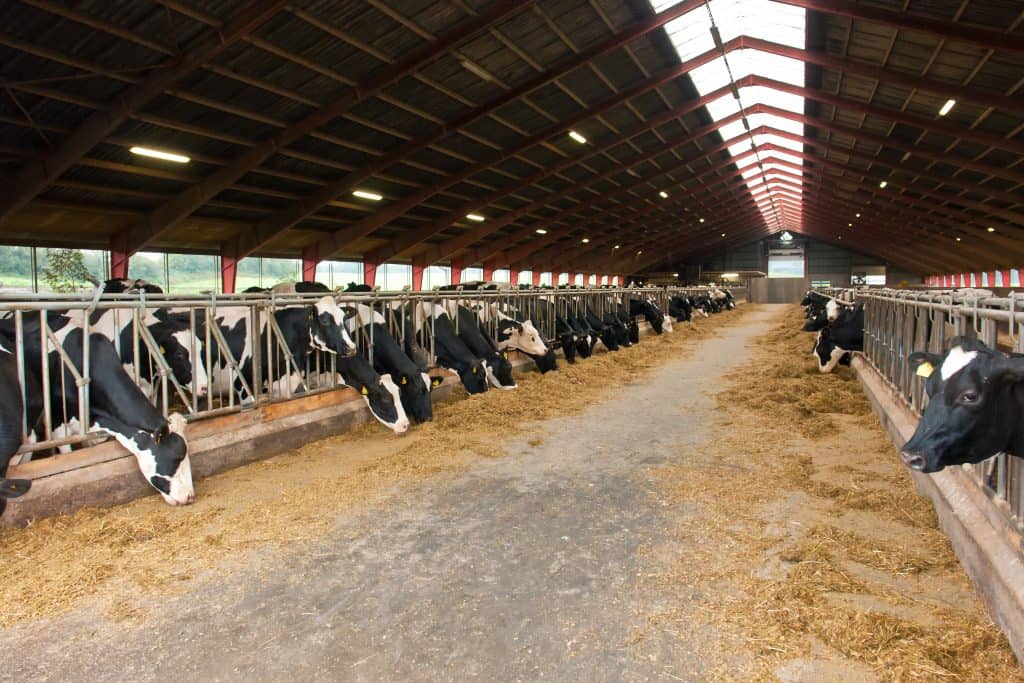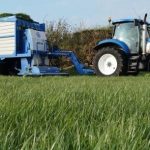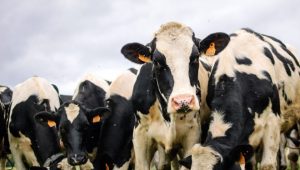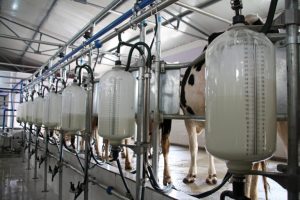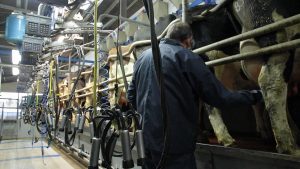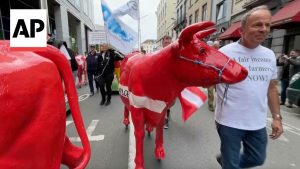
Building on much past progress, there is a great deal of opportunity to further increase environmental sustainability in dairy farming in Europe and around the world. Indeed, with higher levels of motivation from industry and governments alike to address climate change, new technologies and better genetics, there are more sustainability opportunities than ever.
Many dairy farmers are already using the latest systems to reduce water and electricity use, as well as more eco-friendly barn cleansers. They are also working to reduce nitrogen and to manage manure in much more sustainable ways in order to cut greenhouse gas emissions. In addition, the dairy sectors in many countries are also using food waste and food processing by-products in dairy cattle feed, reducing the resources needed to create feed from crops.
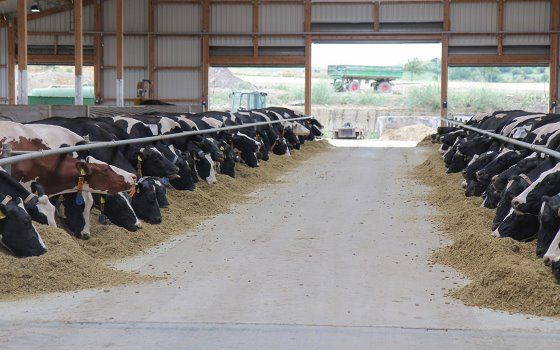
Genetic advancements and breeding
Genetic advancements also continue to help raise cow productivity, again translating into fewer resources being required to market a given volume of milk. There are also new specific initiatives such as the Future Forage Programme in Australia that will further reduce the environmental impact of individual cows through breeding and more.
At the farm level, whilst genetics and new technologies are important in the quest to dairy farm with less environmental impact, dairy farmers also need other sources of support.
In addition, new methods to improve animal health monitoring and prevent illness represent another avenue to reduce emissions. More healthy, productive cows require fewer resources than less-healthy counterparts.
Supported in the change to sustainability
However, at the farm level, whilst genetics and new technologies are important in the quest to dairy farm with less environmental impact, dairy farmers also need other sources of support. This is strongly recognised in a recent report from the Institute for European Environmental Policy (IEEP), entitled ‘A vision for the future of the European dairy industry’.
In this report, IEEP external impact director, Faustine Bas-Defossez and her colleagues, note that moving Europe’s dairy sector towards greater sustainability requires a ‘just transition’ in which those affected within the sector are supported in the change to greater sustainability. “They must be enabled to be part of the change,” she says.
All initiatives important
To be successful with greater dairy sector sustainability, government decision-makers, consumers and the entire supply chain must all work together, notes Bas-Defossez. “All categories of initiatives are very important and they are all interconnected,” she says. “There are more formal policies, and also the EU’s Common Agricultural Policy shapes the practises on the ground and provides the criteria for subsidies that can support more sustainability.”
Factors that matter to consumers
But whilst consumers worldwide now have high expectations for reduced environmental impact for all their goods and services, Bas-Defossez notes that in the dairy sector’s relationship with consumers, meaningful product labelling and explanations of sustainability progress are very important.
“Some sustainability marketing campaigns do not always make things clear and sometimes also only focus on one or two aspects of sustainability,” she explains, adding that we need to understand and keep in mind the other factors that matter to consumers when making their purchasing decisions.
Pricing of dairy products
When asked about one of those important factors – price – Bas-Defossez expresses the view that the price of dairy products in Europe should not rise as sustainability progress is made. Rather, she says, there should be mechanisms in place that support these advances to gradually become the norm without the need to increase product costs.
I might suggest that biodigesters would be something that dairy farmers could focus on first to make significant gains.
Areas of environmental sustainability
In terms of particular areas of environmental sustainability that the European dairy industry should focus on (or the areas that should be stressed to consumers where the most significant advances are being made), Bas-Defossez says this is difficult to answer. Renewable energy use, manure management practices, reduction of water and electricity use – they are all interconnected and important.
“We don’t want to place greenhouse gas emissions as more important than water quality or air quality,” observes Bas-Defossez. “Everything must be done and the challenges are large, but perhaps, given the climate emergency and EU carbon neutrality objectives, I might suggest that biodigesters would be something that dairy farmers could focus on first to make significant gains.”
Shared responsibility
Overall, Bas-Defossez believes members of the EU dairy industry should be optimistic that they will reach their ambitious sustainability goals. “Many tools need to be activated and the responsibility must not be just on the shoulders of farmers,” she says, “but continued progress will be made with everyone involved including consumers and the right policies and financial supports.”
Feeding strategies
A recent 6-year US research project called the Dairy Coordinated Agricultural Project assessed practises that can help farmers reduce greenhouse gas (GHG) emissions. The study found, to no one’s surprise, that genetics, improved feeding strategies and better manure management are all important.
In terms of specific feeding strategies that reduce cow (enteric) emissions of methane, project director, Dr Mark Ruark of the University of Wisconsin-Madison notes that “all the little things [farmers] can do to improve feed efficiency add up.”
The feeding conundrum
His colleague, Dr Michel Wattiaux, explains further, noting that feeding strategies to reduce enteric emissions are somewhat of a conundrum. “Feeding low fibre/high concentrate diets reduces enteric emission compared to high fibre/low concentrate diets,” he explains, “but in the former, we make cows consume a diet in ‘competition’ with humans, rather than ‘complementary’ to human feed resources. But in the latter, milk production may be reduced leading to an increase in emission per kg of milk.”
Dairy cattle concentrates are rich in protein and energy and can contain a wide range of high-value crop ingredients, from barley, canola meal, corn and oats to wheat, molasses and beet pulp.
At the same time, however, Wattiaux reminds us that there are now a number of commercial products such as seaweed or 3-NOP that have been shown to reduce emissions without affecting milk production.
Manure management
With regard to feeding strategies that reduce nitrogen emissions from manure (to air as ammonia and/or water as nitrate), Wattiaux says a reduction of dietary protein concentration would make a difference, but farmers and dairy nutritionists “don’t want to take a chance and thus still use a ‘safety margin’ which ends up in manure for the most part”.
In terms of the best manure management to reduce emissions, Ruark echoes Bas-Defossez’ idea that digesters should be a dairy industry focus. “It really is about enteric methane and reducing greenhouse gases from the manure before land application,” he says. “So, all investments should focus on those aspects of production.”
Sustainability in developing countries
Dr Marion de Vries at Wageningen University and Research in the Netherlands, with colleagues there and in Indonesia, has recently published a paper noting that whilst increasing milk yield would help fight climate change mitigation strategy for small-scale dairy farms in developing countries, this is difficult to achieve.
Productivity gains are a matter of genetics and several other factors, and even if cows with better genetics were to be distributed from more developed to less-developed countries, De Vries notes that genetic potential can only be reached if supported by proper animal management and husbandry, which is often not the case in developing countries.
“Also, note that ‘absolute’ emissions per animal will be higher in case of higher productivity,” she explains. “This is due to a higher feed intake and manure excretion. So, although increasing milk yield per cow is promising to reduce GHG emissions per kg milk (i.e. relative emissions, also called ‘emission intensity’), this strategy will increase absolute emissions if the size of the national herd population is kept the same.”
De Vries also points out that more sustainable manure management techniques in developing countries depend greatly on local conditions and farm types. “For smallholder farmers, only low-cost solutions will be feasible, for example, daily spread,” she says. [It’s]…a very low cost, low-emission and simple option, but often not applicable due to lack of land close to barns.”
